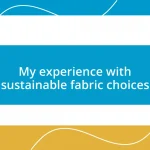Key takeaways:
- Embracing slow fashion transforms the consumer’s relationship with clothing, encouraging mindfulness, ethical considerations, and a focus on quality over quantity.
- Building a capsule wardrobe fosters personal style clarity and emotional connections to garments, making each piece meaningful and memorable.
- Supporting ethical brands creates a positive impact on communities and the environment, empowering consumers to participate in a movement toward mindful fashion.
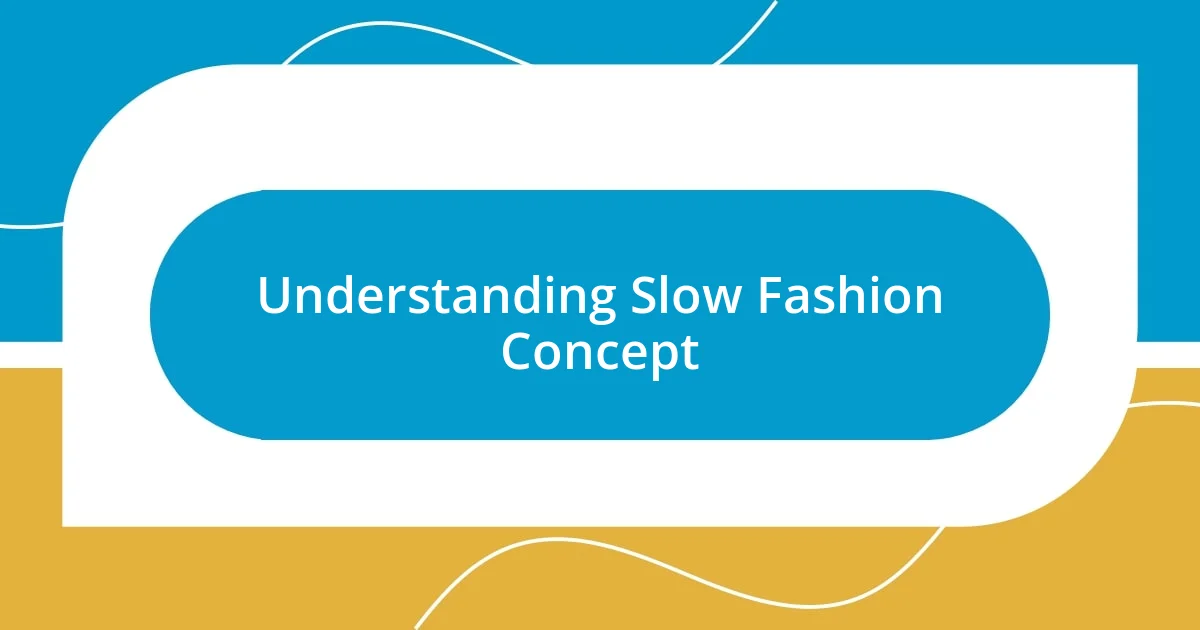
Understanding Slow Fashion Concept
The concept of slow fashion resonates deeply with me, primarily because it stands in stark contrast to the fast-paced, disposable culture we often encounter. I remember the first time I held a handwoven scarf made from organic fibers; the love and craftsmanship infused in that piece made me appreciate its story. Isn’t it fascinating how a single garment can carry the weight of artisanal skill and personal commitment to sustainability?
Slow fashion encourages us to rethink our relationship with clothing, prompting questions like, “What do I truly need?” I found that by investing in fewer, high-quality items, I not only saved money but also enjoyed a wardrobe that felt more meaningful. When I look at pieces I’ve chosen intentionally, I feel a personal connection that fast fashion simply cannot offer.
Furthermore, understanding slow fashion is about embracing mindfulness in our consumption habits. I’ve started reflecting on the environmental impact of my choices and the ethical implications behind brands. This shift in mindset has genuinely felt empowering, as if I’m not just wearing clothes but advocating for a lifestyle that respects both people and the planet. How many of us have considered how our buying habits shape the world around us?

Benefits of Slow Fashion Practices
The beauty of slow fashion practices lies in their numerous benefits for both the environment and consumer well-being. Personally, I’ve noticed a significant reduction in my wardrobe clutter since embracing this approach. With each carefully chosen piece, I feel a stronger connection to my style, making getting dressed each day a delight rather than a chore.
Moreover, slow fashion promotes ethical labor practices. I remember attending a local artisan market where I met a designer committed to fair wages and safe working conditions. It was heartwarming to know that my purchase was not just fueling exploitation but supporting a community instead. This deeper connection with the brands I buy from transforms shopping into a mindful activity.
Beyond ethical implications, slow fashion encourages durability and longevity in fashion. Investing in quality garments has not only saved me money in the long run but also provided me with a collection of reliable pieces that withstand trends. My favorite pair of jeans—worn for years—has become a staple precisely because it was built to last, continually reminding me that value lies in craftsmanship.
| Benefit | Personal Insight |
|---|---|
| Reduced Clutter | Less frequent shopping leads to a streamlined wardrobe. |
| Support for Fair Labor | Connecting with ethical brands transforms shopping experiences. |
| Durability | Quality garments save money and build a timeless wardrobe. |

Evaluating Sustainable Materials
When evaluating sustainable materials, I’ve come to appreciate how crucial it is to delve into sourcing and production processes. For instance, I recently came across a cozy sweater made of Tencel, a fabric derived from sustainably sourced wood pulp. The softness caught my attention, but what really resonated with me was learning how the production process uses far less water compared to traditional cotton. I never realized that choosing one type of fabric over another could impact water conservation so significantly. It’s an eye-opener.
Here are some aspects I consider when evaluating sustainable materials:
- Source of fibers: Are they biodegradable or derived from renewable resources?
- Production methods: Is the manufacturing process ecological, minimizing water and energy use?
- Chemical usage: Are the dyes and treatments used non-toxic and eco-friendly?
- Supply chain transparency: Can the brand trace the journey of their materials from production to final product?
- Durability: How well do the materials hold up over time to reduce waste?
Each element can shape my understanding of sustainability and influence my purchasing choices. After all, the fabric I wear connects not just to my personal style but also to broader, systemic environmental impacts.
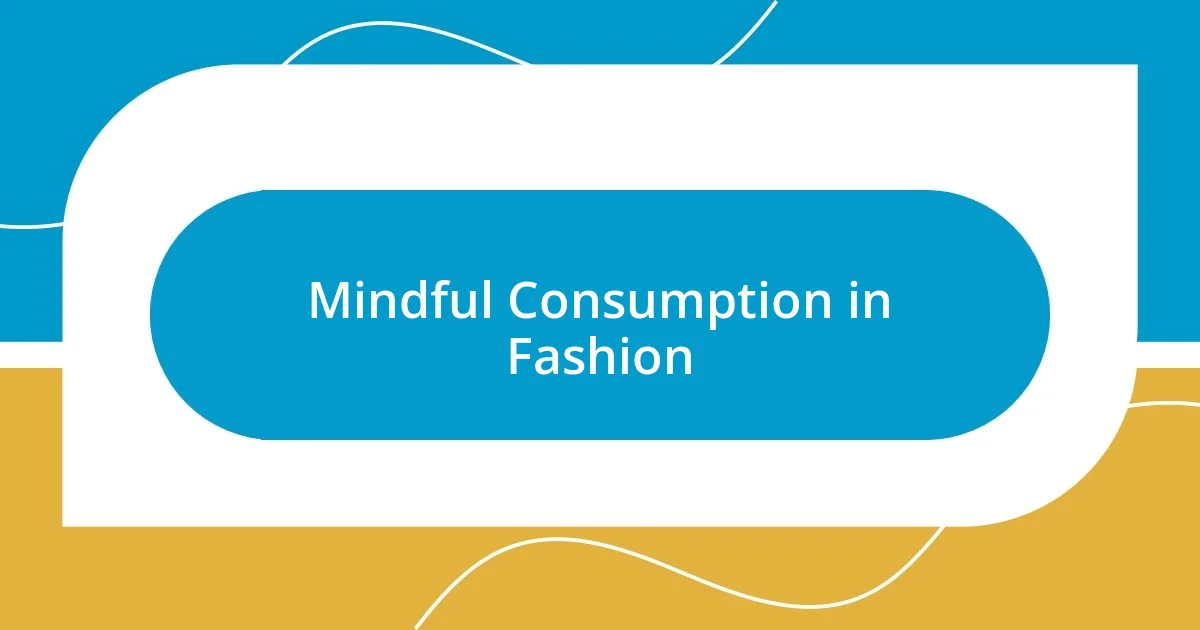
Mindful Consumption in Fashion
Embracing mindful consumption in fashion has been a transformative journey for me. I remember the first time I hesitated before a purchase—a stunning dress caught my eye, but I paused to consider its origin. Was it produced ethically? Would it still fit my style next season? This introspection shifted my perspective on shopping; it became less about impulse and more about intention.
One significant realization I had was about the stories behind my clothing. Most recently, I invested in a hand-sewn bag from a local artisan who shared her journey of craftsmanship. As she talked about her process, I felt a unique connection to the item. It was incredible to think that my choice supported not only her livelihood but also a rich tradition of artistry in fashion. This connection has added so much depth to my wardrobe, transforming each piece into a conversation starter.
Mindful consumption, I’ve found, isn’t just about what I choose to wear but also what I choose to leave behind. I frequently ask myself: Do I really need another item that will likely end up in a landfill? This question drives me to be more discerning and grateful for what I already have. By curating a wardrobe filled with intention, I’ve learned to appreciate quality over quantity and find joy in each garment I wear.
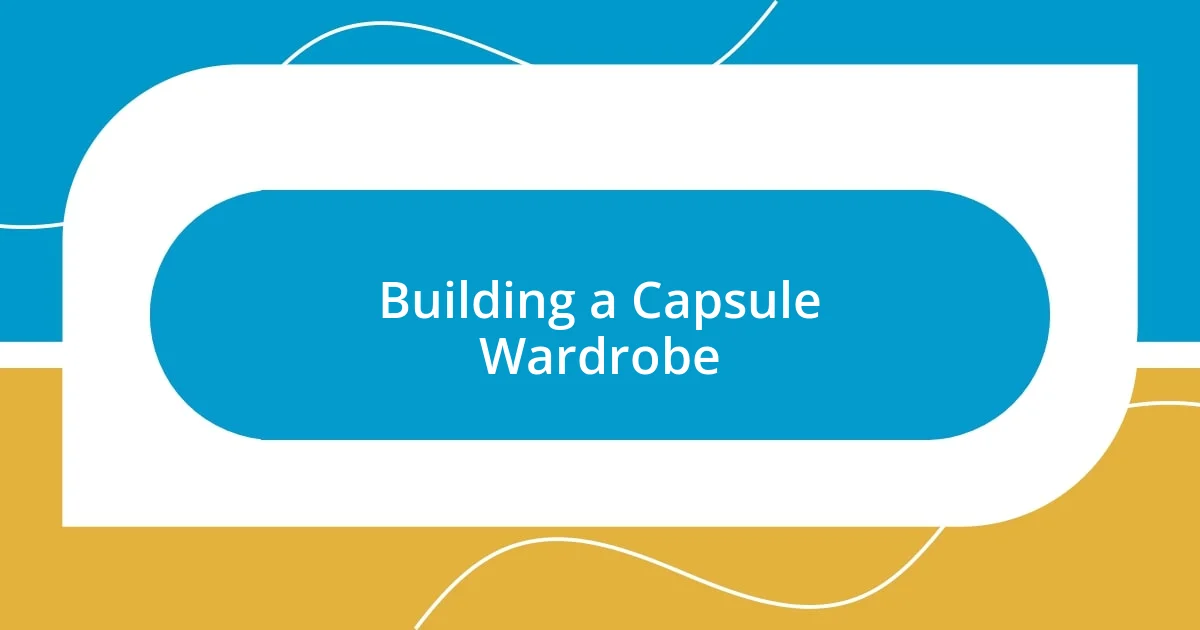
Building a Capsule Wardrobe
Building a capsule wardrobe has been a game changer for me. I recall the overwhelming mornings spent sifting through piles of clothes, trying to find something that resonated with my style mood that day. By intentionally selecting versatile pieces that I love and can mix and match, I’ve simplified my mornings and, in turn, my life—it’s illuminating how a curated wardrobe can offer both clarity and excitement.
As I layered my selected items, I realized that each piece holds a story. For instance, my favorite denim jacket isn’t just an article of clothing; it reminds me of a road trip I took with friends. We stopped at a vintage shop where I found that jacket tucked away, and the thrill of the discovery still makes me smile. This emotional connection transforms my wardrobe into a treasure trove of memories, making every outfit meaningful.
I often ponder over what truly defines my personal style and how the concept of a capsule wardrobe has helped me articulate it. Is it a reflection of my values, a canvas for self-expression, or both? I’ve come to see it as a balance—the harmony between comfort and flair. Choosing thoughtfully curated items that resonate with who I am helps me feel confident and unapologetically authentic, and there’s an undeniable power in that realization.

Supporting Ethical Brands
When I decided to actively support ethical brands, I felt a wave of empowerment wash over me. Each purchase became a conscious choice, a way to align my spending habits with my values. I remember one specific moment—finding a sustainable loungewear set from a small, eco-friendly brand that highlighted their fair labor practices and use of organic materials. It was rewarding to know that my purchase contributed positively to someone’s life while also promoting a healthier planet.
Exploring ethical fashion also led me to discover the beauty of transparency. I recently researched a brand focusing on sustainable production methods, and their commitment to traceability struck a chord with me. I learned how they sourced materials responsibly and built relationships with their suppliers. Suddenly, buying my clothes felt less like a fleeting transaction and more like a partnership, as my choices reinforced practices that I believe in. Isn’t it uplifting to know that our clothing can tell stories of integrity?
I often reflect on how supporting ethical brands allows me to contribute to a larger movement. It’s about creating a ripple effect—by choosing to buy from brands that prioritize people and the planet, I feel part of something meaningful. I regularly think: How can I encourage others to participate in this journey of mindful fashion? By sharing my experiences and highlighting ethical brands, I hope to inspire friends and family to embrace this transformative approach to fashion as well.
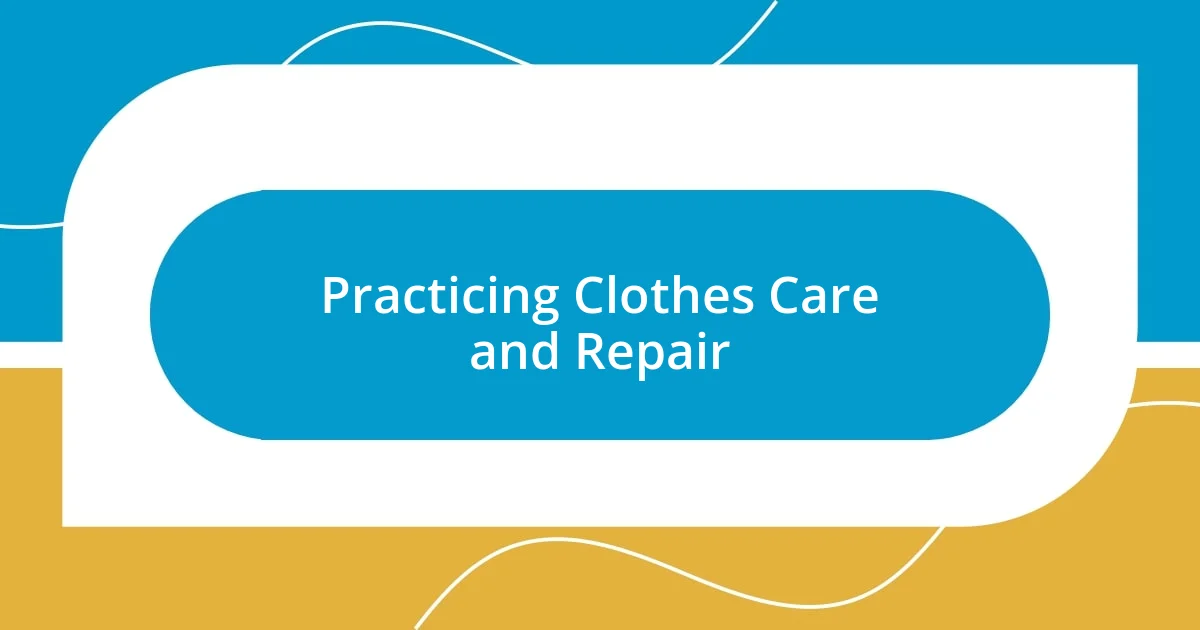
Practicing Clothes Care and Repair
Taking care of my clothes has become an essential part of my slow fashion journey. I remember the first time I meticulously hand-washed a delicate blouse instead of tossing it in the machine. Feeling the soft fabric in my hands, I realized this simple act of care could not only extend the life of my clothes but also deepen my appreciation for each piece I own. When did I last pause to truly cherish my wardrobe?
Repairing clothes, rather than discarding them, has transformed my relationship with fashion. I recall a pair of well-loved sneakers that developed a small tear; instead of replacing them, I took on a DIY project to patch them up. With every stitch, I infused my personality and creativity into those shoes, making them uniquely mine. I often think, isn’t it fascinating how a little effort can turn a regular item into a cherished piece of art?
As I’ve invested time in caring for my wardrobe, I’ve found a sense of pride in crafting a sustainable wardrobe. Recently, I learned how to darn my favorite wool socks, which sparked a sense of nostalgia and joy. Each repaired piece becomes a testament to the journey I’ve shared with my clothes, reminding me that imperfections can add beauty. What stories do your favorite garments hold, and how might caring for them change the way you see fashion?






